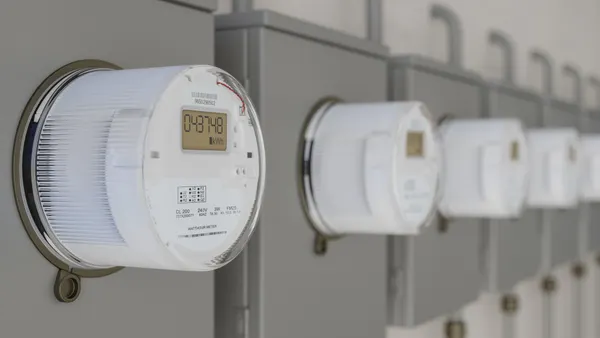Dive Brief:
- The Electric Power Research Institute (EPRI) has found the potential impacts of electromagnetic pulses (EMPs) on transmission substations do not include long-lasting blackouts, national grid failure and mass casualties, as previously reported.
- EPRI's report, published on Tuesday, showed high-altitude EMP attacks, from solar flares to the detonation of a nuclear device, could lead to regional service interruption. "We did not see the dire consequences that some of the other reports have documented," Randy Horton, senior program manager at EPRI, told Utility Dive.
- The findings, culminating a three-year study, assessed ways to mitigate the impact on transmission assets, using options such as shielded cables and low-voltage surge suppression devices or filters, diverting the extra surge to the ground. Going forward, EPRI aims to test hardening practices outside of the lab environment.
Dive Insight:
The utility sector has been grappling with the threat of EMPs for years. Previous analyses of potential EMP attacks led to questions among federal agencies about prioritizing the threats above cybersecurity attacks on the grid due to the dire predicted effects associated with an EMP attack.
In 2017, a commission established by Congress to assess the national threat of EMP attacks testified about its grim report, warning that a North Korean EMP attack "could lead to the death within a year of up to 90% of all Americans."
"You can go pull reports off the Internet right now that say that if a high-altitude EMP event were to occur, you'd have a blackout that can last many months, if not a year, and nine out of 10 Americans would die," Horton said. "Our research and what we did didn't show that."
Department of Energy Assistant Secretary Bruce Walker told a crowd at a legislative conference for National Rural Electric Cooperative Association on Monday that EMP attacks ranked behind physical and cyber attacks on the grid in his list of priorities. Walker said his office worked with EPRI on the report.
Digital protective relays, meant to find faults with the electric system, were mostly resilient to inital EMPs. Transmission substations have been transitioning to digital protective relays from electromechanical relays since the early '90s, and the integration is expected to increase in the future, Horton said. EPRI tested the types of relays used by its members to determine best hardening practices.
The specific techniques and equipment that proved resilient against EMPs need to be tested at live substations, Horton said, to identify potentially unintended consequences and improve designs "to basically have the technology at a level where it can be more broadly applied later on."
The report highlighted several areas of additional study, including the potential impact of EMP attacks on generation facilities, which are "a different animal" than transmission facility attacks and a key component to assessing overall EMP threats, Horton said.













